BN203 Network Security: Threats, Mitigation Strategies Report
VerifiedAdded on 2023/06/07
|6
|1897
|178
Report
AI Summary
This report provides an executive summary of network device security, focusing on the various threats and attacks that can compromise these systems. It identifies key threats such as hijacking, Trojans, DOS/DDOS attacks, spoofing, and sniffing, detailing their mechanisms and potential damages. The report also addresses potential damages including business disruption, intellectual property loss, financial problems, and data breaches. It further explores the challenges faced by organizations and users, such as the increasing number of devices and cyber-crimes, and the lack of security awareness. The report concludes by emphasizing the importance of mitigation strategies, including encryption, cryptography, firewalls, and security plans, along with the need for regular software updates and the adoption of backup plans to safeguard against network security threats. The report also includes references to provide further reading and in-depth understanding.
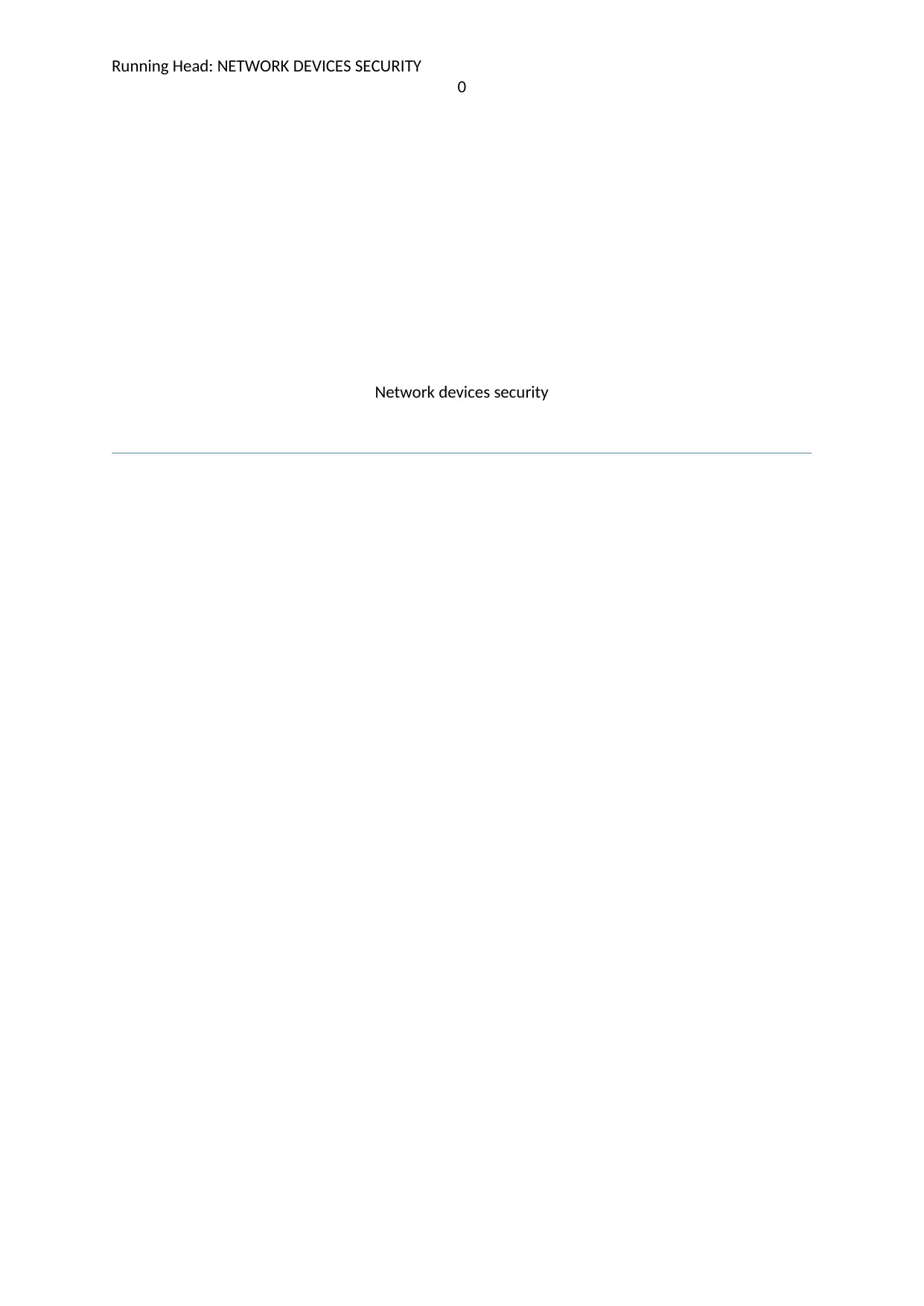
Running Head: NETWORK DEVICES SECURITY
0
Network devices security
0
Network devices security
Paraphrase This Document
Need a fresh take? Get an instant paraphrase of this document with our AI Paraphraser
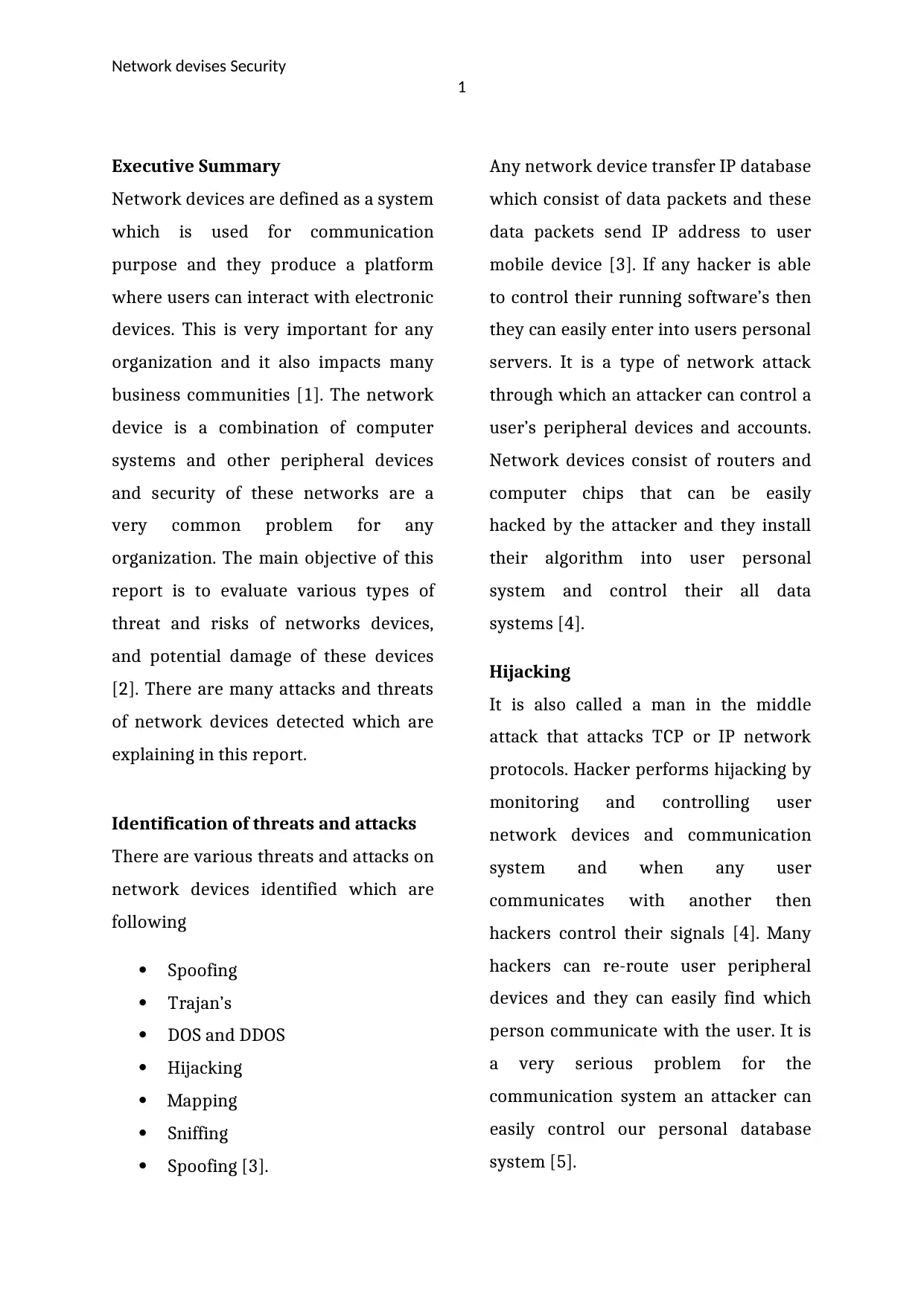
Network devises Security
1
Executive Summary
Network devices are defined as a system
which is used for communication
purpose and they produce a platform
where users can interact with electronic
devices. This is very important for any
organization and it also impacts many
business communities [1]. The network
device is a combination of computer
systems and other peripheral devices
and security of these networks are a
very common problem for any
organization. The main objective of this
report is to evaluate various types of
threat and risks of networks devices,
and potential damage of these devices
[2]. There are many attacks and threats
of network devices detected which are
explaining in this report.
Identification of threats and attacks
There are various threats and attacks on
network devices identified which are
following
Spoofing
Trajan’s
DOS and DDOS
Hijacking
Mapping
Sniffing
Spoofing [3].
Any network device transfer IP database
which consist of data packets and these
data packets send IP address to user
mobile device [3]. If any hacker is able
to control their running software’s then
they can easily enter into users personal
servers. It is a type of network attack
through which an attacker can control a
user’s peripheral devices and accounts.
Network devices consist of routers and
computer chips that can be easily
hacked by the attacker and they install
their algorithm into user personal
system and control their all data
systems [4].
Hijacking
It is also called a man in the middle
attack that attacks TCP or IP network
protocols. Hacker performs hijacking by
monitoring and controlling user
network devices and communication
system and when any user
communicates with another then
hackers control their signals [4]. Many
hackers can re-route user peripheral
devices and they can easily find which
person communicate with the user. It is
a very serious problem for the
communication system an attacker can
easily control our personal database
system [5].
1
Executive Summary
Network devices are defined as a system
which is used for communication
purpose and they produce a platform
where users can interact with electronic
devices. This is very important for any
organization and it also impacts many
business communities [1]. The network
device is a combination of computer
systems and other peripheral devices
and security of these networks are a
very common problem for any
organization. The main objective of this
report is to evaluate various types of
threat and risks of networks devices,
and potential damage of these devices
[2]. There are many attacks and threats
of network devices detected which are
explaining in this report.
Identification of threats and attacks
There are various threats and attacks on
network devices identified which are
following
Spoofing
Trajan’s
DOS and DDOS
Hijacking
Mapping
Sniffing
Spoofing [3].
Any network device transfer IP database
which consist of data packets and these
data packets send IP address to user
mobile device [3]. If any hacker is able
to control their running software’s then
they can easily enter into users personal
servers. It is a type of network attack
through which an attacker can control a
user’s peripheral devices and accounts.
Network devices consist of routers and
computer chips that can be easily
hacked by the attacker and they install
their algorithm into user personal
system and control their all data
systems [4].
Hijacking
It is also called a man in the middle
attack that attacks TCP or IP network
protocols. Hacker performs hijacking by
monitoring and controlling user
network devices and communication
system and when any user
communicates with another then
hackers control their signals [4]. Many
hackers can re-route user peripheral
devices and they can easily find which
person communicate with the user. It is
a very serious problem for the
communication system an attacker can
easily control our personal database
system [5].
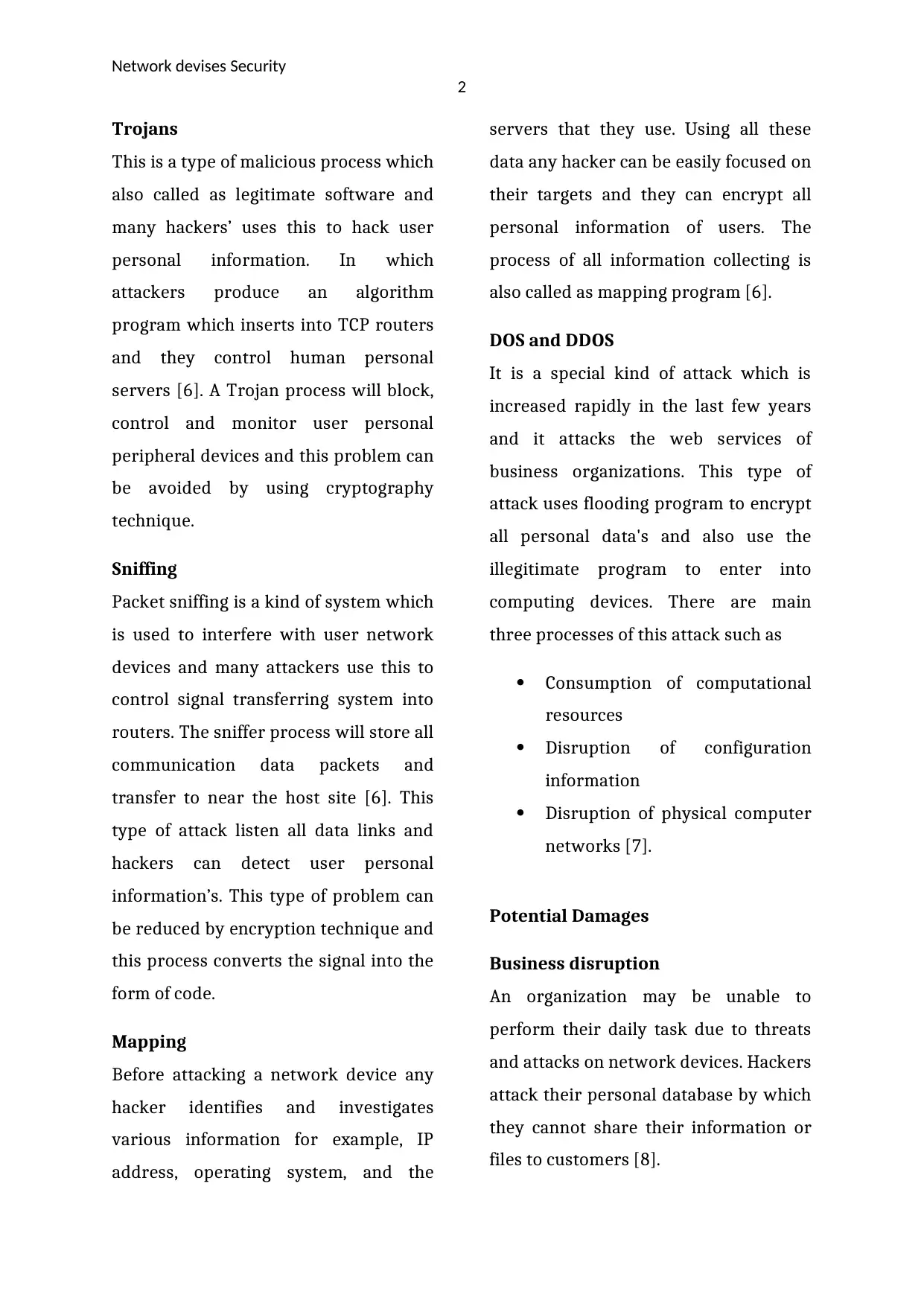
Network devises Security
2
Trojans
This is a type of malicious process which
also called as legitimate software and
many hackers’ uses this to hack user
personal information. In which
attackers produce an algorithm
program which inserts into TCP routers
and they control human personal
servers [6]. A Trojan process will block,
control and monitor user personal
peripheral devices and this problem can
be avoided by using cryptography
technique.
Sniffing
Packet sniffing is a kind of system which
is used to interfere with user network
devices and many attackers use this to
control signal transferring system into
routers. The sniffer process will store all
communication data packets and
transfer to near the host site [6]. This
type of attack listen all data links and
hackers can detect user personal
information’s. This type of problem can
be reduced by encryption technique and
this process converts the signal into the
form of code.
Mapping
Before attacking a network device any
hacker identifies and investigates
various information for example, IP
address, operating system, and the
servers that they use. Using all these
data any hacker can be easily focused on
their targets and they can encrypt all
personal information of users. The
process of all information collecting is
also called as mapping program [6].
DOS and DDOS
It is a special kind of attack which is
increased rapidly in the last few years
and it attacks the web services of
business organizations. This type of
attack uses flooding program to encrypt
all personal data's and also use the
illegitimate program to enter into
computing devices. There are main
three processes of this attack such as
Consumption of computational
resources
Disruption of configuration
information
Disruption of physical computer
networks [7].
Potential Damages
Business disruption
An organization may be unable to
perform their daily task due to threats
and attacks on network devices. Hackers
attack their personal database by which
they cannot share their information or
files to customers [8].
2
Trojans
This is a type of malicious process which
also called as legitimate software and
many hackers’ uses this to hack user
personal information. In which
attackers produce an algorithm
program which inserts into TCP routers
and they control human personal
servers [6]. A Trojan process will block,
control and monitor user personal
peripheral devices and this problem can
be avoided by using cryptography
technique.
Sniffing
Packet sniffing is a kind of system which
is used to interfere with user network
devices and many attackers use this to
control signal transferring system into
routers. The sniffer process will store all
communication data packets and
transfer to near the host site [6]. This
type of attack listen all data links and
hackers can detect user personal
information’s. This type of problem can
be reduced by encryption technique and
this process converts the signal into the
form of code.
Mapping
Before attacking a network device any
hacker identifies and investigates
various information for example, IP
address, operating system, and the
servers that they use. Using all these
data any hacker can be easily focused on
their targets and they can encrypt all
personal information of users. The
process of all information collecting is
also called as mapping program [6].
DOS and DDOS
It is a special kind of attack which is
increased rapidly in the last few years
and it attacks the web services of
business organizations. This type of
attack uses flooding program to encrypt
all personal data's and also use the
illegitimate program to enter into
computing devices. There are main
three processes of this attack such as
Consumption of computational
resources
Disruption of configuration
information
Disruption of physical computer
networks [7].
Potential Damages
Business disruption
An organization may be unable to
perform their daily task due to threats
and attacks on network devices. Hackers
attack their personal database by which
they cannot share their information or
files to customers [8].
⊘ This is a preview!⊘
Do you want full access?
Subscribe today to unlock all pages.

Trusted by 1+ million students worldwide
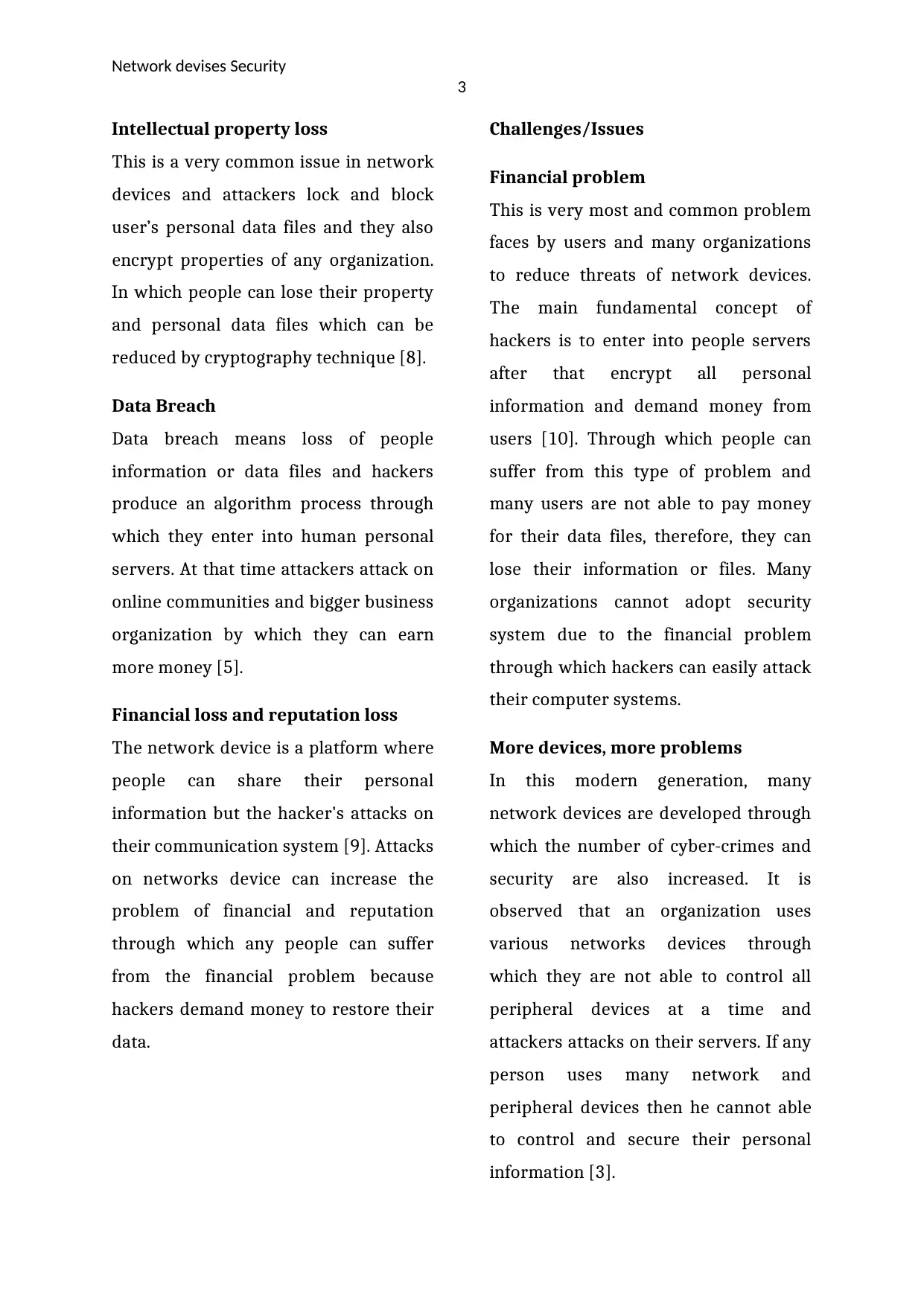
Network devises Security
3
Intellectual property loss
This is a very common issue in network
devices and attackers lock and block
user’s personal data files and they also
encrypt properties of any organization.
In which people can lose their property
and personal data files which can be
reduced by cryptography technique [8].
Data Breach
Data breach means loss of people
information or data files and hackers
produce an algorithm process through
which they enter into human personal
servers. At that time attackers attack on
online communities and bigger business
organization by which they can earn
more money [5].
Financial loss and reputation loss
The network device is a platform where
people can share their personal
information but the hacker's attacks on
their communication system [9]. Attacks
on networks device can increase the
problem of financial and reputation
through which any people can suffer
from the financial problem because
hackers demand money to restore their
data.
Challenges/Issues
Financial problem
This is very most and common problem
faces by users and many organizations
to reduce threats of network devices.
The main fundamental concept of
hackers is to enter into people servers
after that encrypt all personal
information and demand money from
users [10]. Through which people can
suffer from this type of problem and
many users are not able to pay money
for their data files, therefore, they can
lose their information or files. Many
organizations cannot adopt security
system due to the financial problem
through which hackers can easily attack
their computer systems.
More devices, more problems
In this modern generation, many
network devices are developed through
which the number of cyber-crimes and
security are also increased. It is
observed that an organization uses
various networks devices through
which they are not able to control all
peripheral devices at a time and
attackers attacks on their servers. If any
person uses many network and
peripheral devices then he cannot able
to control and secure their personal
information [3].
3
Intellectual property loss
This is a very common issue in network
devices and attackers lock and block
user’s personal data files and they also
encrypt properties of any organization.
In which people can lose their property
and personal data files which can be
reduced by cryptography technique [8].
Data Breach
Data breach means loss of people
information or data files and hackers
produce an algorithm process through
which they enter into human personal
servers. At that time attackers attack on
online communities and bigger business
organization by which they can earn
more money [5].
Financial loss and reputation loss
The network device is a platform where
people can share their personal
information but the hacker's attacks on
their communication system [9]. Attacks
on networks device can increase the
problem of financial and reputation
through which any people can suffer
from the financial problem because
hackers demand money to restore their
data.
Challenges/Issues
Financial problem
This is very most and common problem
faces by users and many organizations
to reduce threats of network devices.
The main fundamental concept of
hackers is to enter into people servers
after that encrypt all personal
information and demand money from
users [10]. Through which people can
suffer from this type of problem and
many users are not able to pay money
for their data files, therefore, they can
lose their information or files. Many
organizations cannot adopt security
system due to the financial problem
through which hackers can easily attack
their computer systems.
More devices, more problems
In this modern generation, many
network devices are developed through
which the number of cyber-crimes and
security are also increased. It is
observed that an organization uses
various networks devices through
which they are not able to control all
peripheral devices at a time and
attackers attacks on their servers. If any
person uses many network and
peripheral devices then he cannot able
to control and secure their personal
information [3].
Paraphrase This Document
Need a fresh take? Get an instant paraphrase of this document with our AI Paraphraser
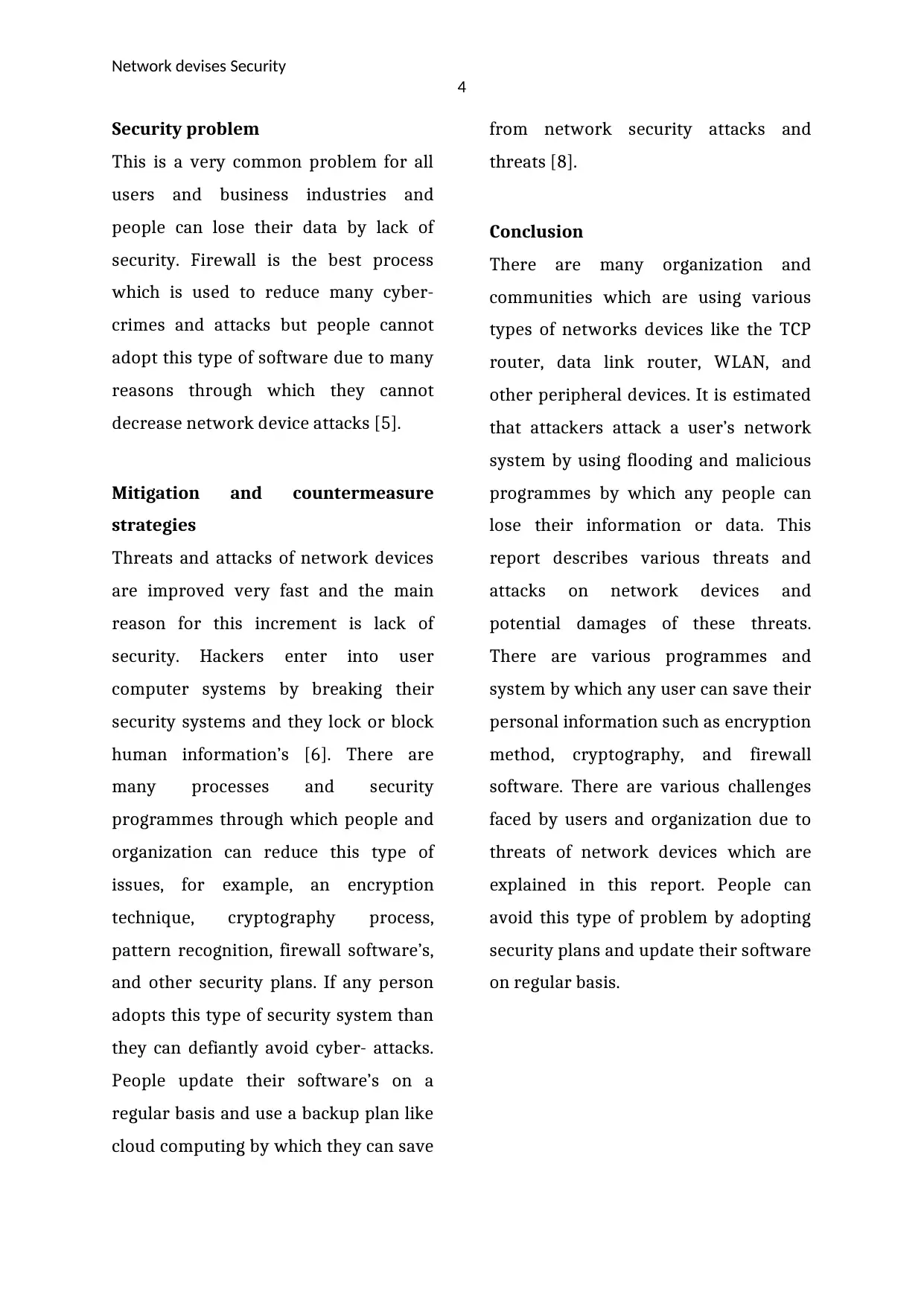
Network devises Security
4
Security problem
This is a very common problem for all
users and business industries and
people can lose their data by lack of
security. Firewall is the best process
which is used to reduce many cyber-
crimes and attacks but people cannot
adopt this type of software due to many
reasons through which they cannot
decrease network device attacks [5].
Mitigation and countermeasure
strategies
Threats and attacks of network devices
are improved very fast and the main
reason for this increment is lack of
security. Hackers enter into user
computer systems by breaking their
security systems and they lock or block
human information’s [6]. There are
many processes and security
programmes through which people and
organization can reduce this type of
issues, for example, an encryption
technique, cryptography process,
pattern recognition, firewall software’s,
and other security plans. If any person
adopts this type of security system than
they can defiantly avoid cyber- attacks.
People update their software’s on a
regular basis and use a backup plan like
cloud computing by which they can save
from network security attacks and
threats [8].
Conclusion
There are many organization and
communities which are using various
types of networks devices like the TCP
router, data link router, WLAN, and
other peripheral devices. It is estimated
that attackers attack a user’s network
system by using flooding and malicious
programmes by which any people can
lose their information or data. This
report describes various threats and
attacks on network devices and
potential damages of these threats.
There are various programmes and
system by which any user can save their
personal information such as encryption
method, cryptography, and firewall
software. There are various challenges
faced by users and organization due to
threats of network devices which are
explained in this report. People can
avoid this type of problem by adopting
security plans and update their software
on regular basis.
4
Security problem
This is a very common problem for all
users and business industries and
people can lose their data by lack of
security. Firewall is the best process
which is used to reduce many cyber-
crimes and attacks but people cannot
adopt this type of software due to many
reasons through which they cannot
decrease network device attacks [5].
Mitigation and countermeasure
strategies
Threats and attacks of network devices
are improved very fast and the main
reason for this increment is lack of
security. Hackers enter into user
computer systems by breaking their
security systems and they lock or block
human information’s [6]. There are
many processes and security
programmes through which people and
organization can reduce this type of
issues, for example, an encryption
technique, cryptography process,
pattern recognition, firewall software’s,
and other security plans. If any person
adopts this type of security system than
they can defiantly avoid cyber- attacks.
People update their software’s on a
regular basis and use a backup plan like
cloud computing by which they can save
from network security attacks and
threats [8].
Conclusion
There are many organization and
communities which are using various
types of networks devices like the TCP
router, data link router, WLAN, and
other peripheral devices. It is estimated
that attackers attack a user’s network
system by using flooding and malicious
programmes by which any people can
lose their information or data. This
report describes various threats and
attacks on network devices and
potential damages of these threats.
There are various programmes and
system by which any user can save their
personal information such as encryption
method, cryptography, and firewall
software. There are various challenges
faced by users and organization due to
threats of network devices which are
explained in this report. People can
avoid this type of problem by adopting
security plans and update their software
on regular basis.
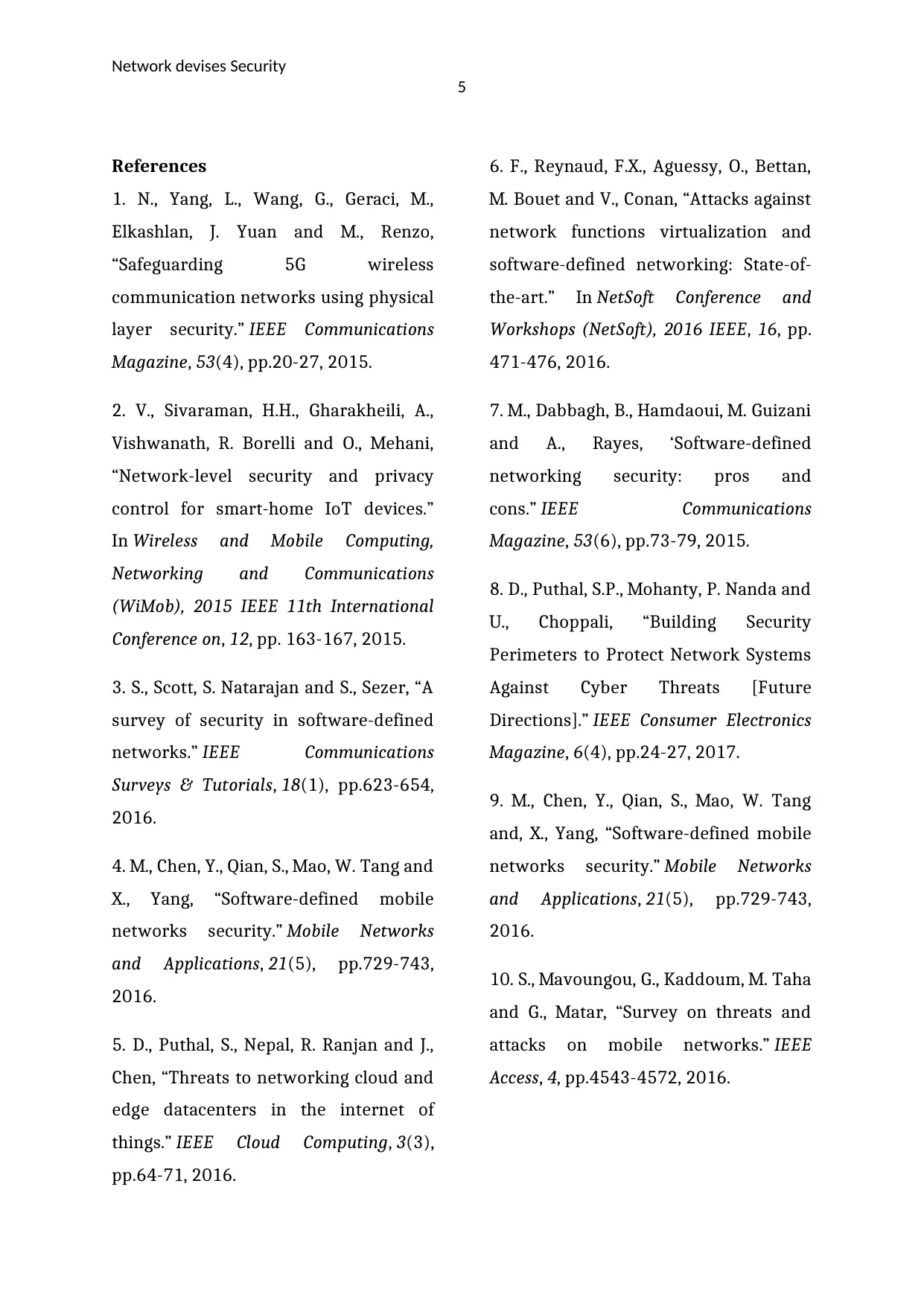
Network devises Security
5
References
1. N., Yang, L., Wang, G., Geraci, M.,
Elkashlan, J. Yuan and M., Renzo,
“Safeguarding 5G wireless
communication networks using physical
layer security.” IEEE Communications
Magazine, 53(4), pp.20-27, 2015.
2. V., Sivaraman, H.H., Gharakheili, A.,
Vishwanath, R. Borelli and O., Mehani,
“Network-level security and privacy
control for smart-home IoT devices.”
In Wireless and Mobile Computing,
Networking and Communications
(WiMob), 2015 IEEE 11th International
Conference on, 12, pp. 163-167, 2015.
3. S., Scott, S. Natarajan and S., Sezer, “A
survey of security in software-defined
networks.” IEEE Communications
Surveys & Tutorials, 18(1), pp.623-654,
2016.
4. M., Chen, Y., Qian, S., Mao, W. Tang and
X., Yang, “Software-defined mobile
networks security.” Mobile Networks
and Applications, 21(5), pp.729-743,
2016.
5. D., Puthal, S., Nepal, R. Ranjan and J.,
Chen, “Threats to networking cloud and
edge datacenters in the internet of
things.” IEEE Cloud Computing, 3(3),
pp.64-71, 2016.
6. F., Reynaud, F.X., Aguessy, O., Bettan,
M. Bouet and V., Conan, “Attacks against
network functions virtualization and
software-defined networking: State-of-
the-art.” In NetSoft Conference and
Workshops (NetSoft), 2016 IEEE, 16, pp.
471-476, 2016.
7. M., Dabbagh, B., Hamdaoui, M. Guizani
and A., Rayes, ‘Software-defined
networking security: pros and
cons.” IEEE Communications
Magazine, 53(6), pp.73-79, 2015.
8. D., Puthal, S.P., Mohanty, P. Nanda and
U., Choppali, “Building Security
Perimeters to Protect Network Systems
Against Cyber Threats [Future
Directions].” IEEE Consumer Electronics
Magazine, 6(4), pp.24-27, 2017.
9. M., Chen, Y., Qian, S., Mao, W. Tang
and, X., Yang, “Software-defined mobile
networks security.” Mobile Networks
and Applications, 21(5), pp.729-743,
2016.
10. S., Mavoungou, G., Kaddoum, M. Taha
and G., Matar, “Survey on threats and
attacks on mobile networks.” IEEE
Access, 4, pp.4543-4572, 2016.
5
References
1. N., Yang, L., Wang, G., Geraci, M.,
Elkashlan, J. Yuan and M., Renzo,
“Safeguarding 5G wireless
communication networks using physical
layer security.” IEEE Communications
Magazine, 53(4), pp.20-27, 2015.
2. V., Sivaraman, H.H., Gharakheili, A.,
Vishwanath, R. Borelli and O., Mehani,
“Network-level security and privacy
control for smart-home IoT devices.”
In Wireless and Mobile Computing,
Networking and Communications
(WiMob), 2015 IEEE 11th International
Conference on, 12, pp. 163-167, 2015.
3. S., Scott, S. Natarajan and S., Sezer, “A
survey of security in software-defined
networks.” IEEE Communications
Surveys & Tutorials, 18(1), pp.623-654,
2016.
4. M., Chen, Y., Qian, S., Mao, W. Tang and
X., Yang, “Software-defined mobile
networks security.” Mobile Networks
and Applications, 21(5), pp.729-743,
2016.
5. D., Puthal, S., Nepal, R. Ranjan and J.,
Chen, “Threats to networking cloud and
edge datacenters in the internet of
things.” IEEE Cloud Computing, 3(3),
pp.64-71, 2016.
6. F., Reynaud, F.X., Aguessy, O., Bettan,
M. Bouet and V., Conan, “Attacks against
network functions virtualization and
software-defined networking: State-of-
the-art.” In NetSoft Conference and
Workshops (NetSoft), 2016 IEEE, 16, pp.
471-476, 2016.
7. M., Dabbagh, B., Hamdaoui, M. Guizani
and A., Rayes, ‘Software-defined
networking security: pros and
cons.” IEEE Communications
Magazine, 53(6), pp.73-79, 2015.
8. D., Puthal, S.P., Mohanty, P. Nanda and
U., Choppali, “Building Security
Perimeters to Protect Network Systems
Against Cyber Threats [Future
Directions].” IEEE Consumer Electronics
Magazine, 6(4), pp.24-27, 2017.
9. M., Chen, Y., Qian, S., Mao, W. Tang
and, X., Yang, “Software-defined mobile
networks security.” Mobile Networks
and Applications, 21(5), pp.729-743,
2016.
10. S., Mavoungou, G., Kaddoum, M. Taha
and G., Matar, “Survey on threats and
attacks on mobile networks.” IEEE
Access, 4, pp.4543-4572, 2016.
⊘ This is a preview!⊘
Do you want full access?
Subscribe today to unlock all pages.

Trusted by 1+ million students worldwide
1 out of 6
Related Documents
Your All-in-One AI-Powered Toolkit for Academic Success.
+13062052269
info@desklib.com
Available 24*7 on WhatsApp / Email
![[object Object]](/_next/static/media/star-bottom.7253800d.svg)
Unlock your academic potential
Copyright © 2020–2025 A2Z Services. All Rights Reserved. Developed and managed by ZUCOL.





